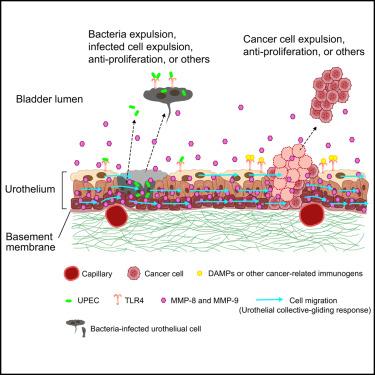尿路上皮集体滑动反应是toll样受体4相关的防御机制
IF 4.1
2区 综合性期刊
Q1 MULTIDISCIPLINARY SCIENCES
引用次数: 0
摘要
细胞集体迁移(CCM)的特点是细胞群的协调运动,同时保持细胞间的内聚。尽管对CCM进行了广泛的研究,但成熟上皮细胞在响应外部刺激时在细胞外基质上的集体迁移尚未报道。通过小鼠活体成像,我们鉴定了由免疫原性物质触发的尿路上皮CCM (UCCM),包括膀胱癌细胞(MB49)和尿路致病性大肠杆菌(UPEC)。整合素信号抑制剂抑制UCCM,显著促进MB49肿瘤生长和UPEC膀胱感染。UCCM的启动涉及toll样受体4 (TLR4),我们将这种TLR4相关的UCCM称为尿路上皮集体滑动反应(UCGR)。在整合素信号的下游,尿路上皮基质金属蛋白酶(MMP)-8和MMP-9介导UCGR。膀胱内灌注这些因子加速UCCM,抑制肿瘤生长和感染。UCGR可能代表了tlr4相关的防御机制,为难治性膀胱炎和内镜切除后复发性非肌性浸润性膀胱癌等膀胱疾病提供了潜在的治疗策略。本文章由计算机程序翻译,如有差异,请以英文原文为准。

Urothelial collective-gliding response acts as a toll-like receptor 4-associated defense mechanism
Collective cell migration (CCM) is characterized by the coordinated movement of cell groups while maintaining cell-to-cell cohesion. Despite extensive research on CCM, the collective migration of mature epithelial cells over the extracellular matrix in response to external stimuli has not been reported. Using intravital imaging in mice, we identified urothelial CCM (UCCM) triggered by immunogenic substances, including bladder cancer cells (MB49) and uropathogenic Escherichia coli (UPEC). Integrin signaling inhibitors suppress UCCM, significantly enhancing MB49 tumor growth and UPEC bladder infection. UCCM initiation involves Toll-like receptor 4 (TLR4), we designated this TLR4-associated UCCM as the urothelial collective-gliding response (UCGR). Downstream of integrin signaling, urothelial matrix metalloproteinases (MMP)-8 and MMP-9 mediate UCGR. Intravesical instillation of these factors accelerates UCCM and inhibits tumor growth and infection. UCGR may represent a TLR4-associated defense mechanism, offering potential therapeutic strategies for bladder disorders such as refractory cystitis and recurrent non-muscle invasive bladder cancer after endoscopic resection.
求助全文
通过发布文献求助,成功后即可免费获取论文全文。
去求助
来源期刊

iScience
Multidisciplinary-Multidisciplinary
CiteScore
7.20
自引率
1.70%
发文量
1972
审稿时长
6 weeks
期刊介绍:
Science has many big remaining questions. To address them, we will need to work collaboratively and across disciplines. The goal of iScience is to help fuel that type of interdisciplinary thinking. iScience is a new open-access journal from Cell Press that provides a platform for original research in the life, physical, and earth sciences. The primary criterion for publication in iScience is a significant contribution to a relevant field combined with robust results and underlying methodology. The advances appearing in iScience include both fundamental and applied investigations across this interdisciplinary range of topic areas. To support transparency in scientific investigation, we are happy to consider replication studies and papers that describe negative results.
We know you want your work to be published quickly and to be widely visible within your community and beyond. With the strong international reputation of Cell Press behind it, publication in iScience will help your work garner the attention and recognition it merits. Like all Cell Press journals, iScience prioritizes rapid publication. Our editorial team pays special attention to high-quality author service and to efficient, clear-cut decisions based on the information available within the manuscript. iScience taps into the expertise across Cell Press journals and selected partners to inform our editorial decisions and help publish your science in a timely and seamless way.
 求助内容:
求助内容: 应助结果提醒方式:
应助结果提醒方式:


